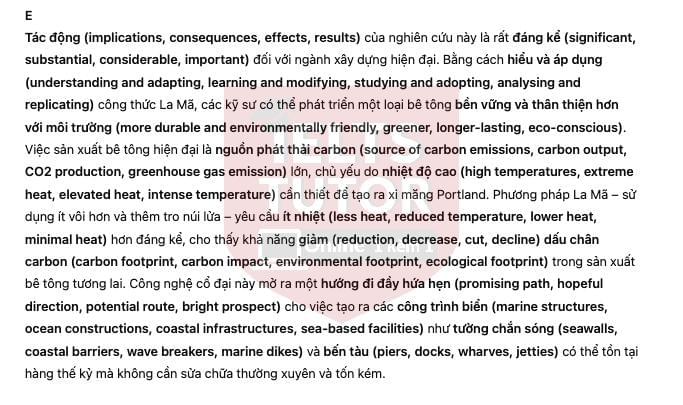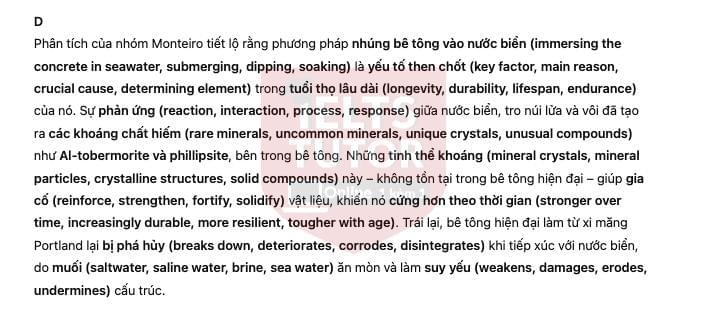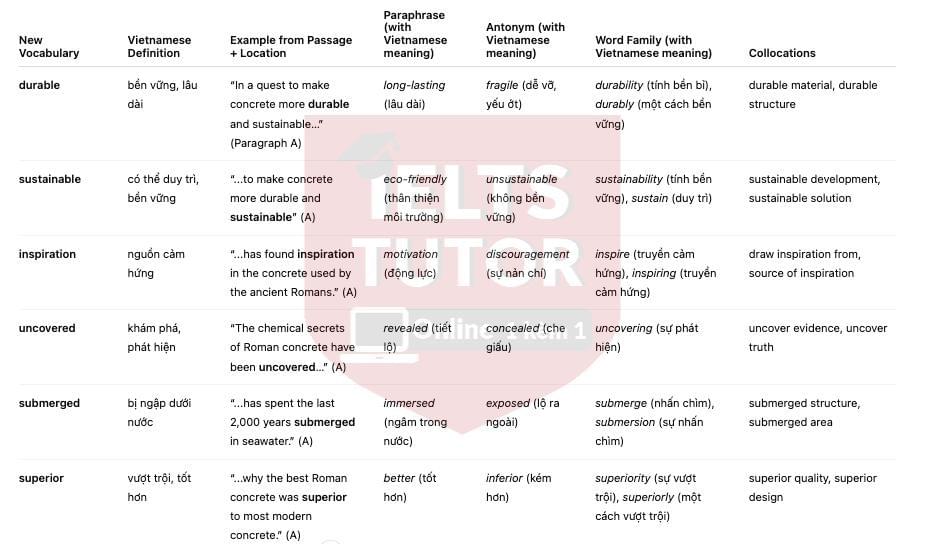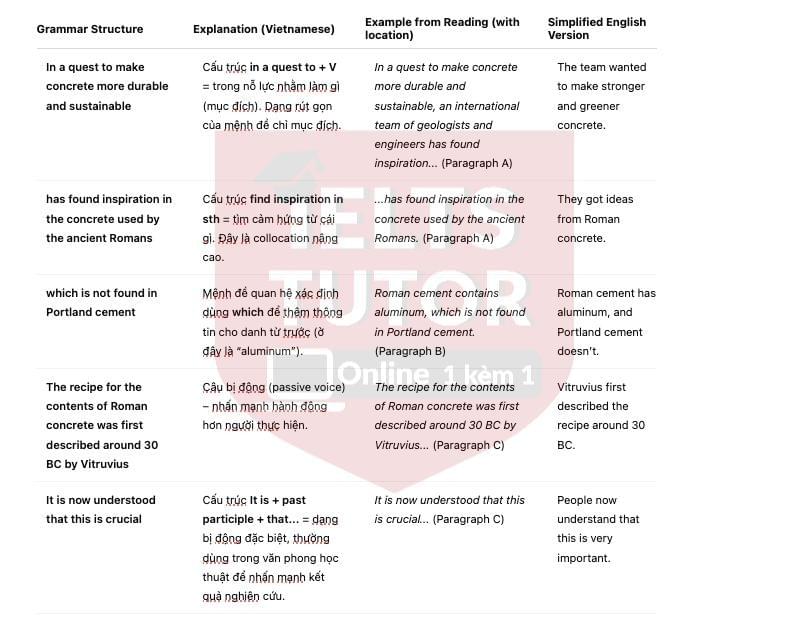IELTS TUTOR cung cấp 🔥Learning from the Romans - How an ancient building material is influencing modern construction Answers with location - Đề luyện IELTS READING- Làm bài online format computer-based, kèm đáp án, dịch & giải thích từ vựng - cấu trúc ngữ pháp khó
I. Kiến thức liên quan
II. Làm bài online (kéo xuống cuối bài blog để xem giải thích từ vựng & cấu trúc cụ thể hơn)
📩 MN AI CHƯA CÓ ĐÁP ÁN FORECAST QUÝ MỚI PART 1-2-3 NHẮN ZL 0905834420 IELTS TUTOR GỬI FREE HẾT NHA
III. Learning from the Romans - How an ancient building material is influencing modern construction: Đề luyện IELTS READING (IELTS Reading Practice Test)
Learning from the Romans
How an ancient building material is influencing modern construction
A
In a quest to make concrete more durable and sustainable, an international team of geologists and engineers has found inspiration in the concrete used by the ancient Romans. The chemical secrets of Roman concrete have been uncovered in samples taken from a concrete Roman breakwater. A breakwater is a barrier that is built out into the sea to protect coasts and harbor them the force of waves. This particular breakwater has spent the last 2,000 years submerged in seawater. The international team of researchers that collected the samples was led by Paulo Monteiro, a professor of civil and environmental engineering at the University of California, Berkeley. Analysis of samples from the ancient underwater site in Pozzuoli Bay near Naples in Italy, and pinpointed why the best Roman concrete was superior to most modern concrete.
B
Concrete was the Roman Empire’s construction material of choice. It was used in land monuments such as the Pantheon in Rome, as well as in underwater and partially underwater coastal and harbor structures. Monteiro and his team were particularly interested in how the coastal and harbor structures endured by microjiving saltwater environment. Chemical analysis of Roman concrete showed that it differs from the modern kind in several ways. One is the content of the cement that binds the material in the concrete. The most commonly used cement in recent decades has been Portland cement. Portland cement is a compound of calcium, silicon, and hydrates (C-S-H). However, analysis of Roman concrete shows that it contains a significantly different cement. Roman cement contains aluminum, which is not found in Portland cement, and less silicon than is found in Portland cement. The resulting calcium-aluminum-silicate-hydrate (C-A-S-H) is an exceptionally stable cement.>> Form đăng kí giải đề thi thật IELTS 4 kĩ năng kèm bài giải bộ đề 100 đề PART 2 IELTS SPEAKING quý đang thi (update hàng tuần) từ IELTS TUTOR
C
The recipe for the contents of Roman concrete was first described around 30 BC by Vitruvius, an engineer for the Roman Emperor Augustus. Volcanic ash was one of the ingredients, and it is now understood that this is crucial, as it is volcanic ash that contains the aluminum that ultimately gives Roman concrete the great durability. The Romans devised an efficient method of making concrete for coastal structures. They combined volcanic ash with lime, which added the calcium to the mix. This was then packed, together with stones and chunks of rock, into wooden molds, which were then immersed in seawater. The seawater instantly triggered a hot chemical reaction. The lime was hydrated by the seawater, which means that it incorporated water molecules into its structure, and reacted with the volcanic ash to cement the whole mixture together. This reaction formed the concrete that was used to build some of the most enduring structures in human civilisation.
D
The analysis by Monteiro's team revealed that the Roman method of immersing the concrete in seawater was a key factor in its longevity. The seawater reacting with the volcanic ash and lime caused the growth of rare minerals, such as Al-tobermorite and phillipsite, within the concrete. These mineral crystals, which are not found in modern concrete, helped to reinforce the material, making it stronger over time. In contrast, modern Portland cement concrete breaks down when exposed to seawater, as the saltwater corrodes the compounds and weakens the structure.
E
The implications of this research are significant for modern construction. By understanding and adapting the Roman recipe, engineers could develop a new, more durable, and environmentally friendly concrete. Modern concrete production is a major source of carbon emissions, primarily due to the high temperatures required to produce Portland cement. The Roman method, which uses less lime and incorporates volcanic ash, requires significantly less heat, suggesting a potential reduction in the carbon footprint of future concrete production. This ancient technology offers a promising path towards creating marine structures, such as seawalls and piers, that can last for centuries without requiring frequent and costly repairs.
Questions 14–19
The reading passage has five paragraphs, A–E.
Which paragraph contains the following information?
Write the correct letter, A–E, in boxes 14–19 on your answer sheet.
NB You may use any letter more than once.
A description of the chemical process that strengthened the Roman concrete over time.
The name of the person who first recorded the composition of Roman concrete.
The main environmental advantage of adopting the Roman concrete-making method today.
The specific location where the research samples were collected.
A comparison of how modern and Roman concrete behave in seawater.
The two key minerals that contributed to the strength of the Roman concrete.
Questions 20–26
Complete the summary below.
Choose NO MORE THAN TWO WORDS from the passage for each answer.
Write your answers in boxes 20–26 on your answer sheet.
Roman Concrete vs. Modern Concrete
Research into an ancient Roman 20 ....................... has provided new insights into concrete. The study, led by Paulo Monteiro, analyzed samples that had been submerged in seawater for two millennia.
The analysis showed that Roman concrete uses a different binding cement. While modern 21 ....................... cement is a compound of calcium, silicon, and hydrates, Roman cement includes 22 ....................... and less silicon, forming a very stable compound called C-A-S-H.>> IELTS TUTOR gợi ý tham khảo CẦN VIẾT & THU ÂM BAO NHIÊU BÀI ĐỂ ĐẠT 8.0 SPEAKING & 7.0 WRITING?
A key ingredient in the Roman recipe was 23 ......................., which provided the aluminum. The Romans made their concrete for coastal structures by mixing this with lime, placing the mixture in 24 ......................., and then immersing it in seawater. This immersion caused a hot chemical reaction.
A significant finding was that this process led to the growth of rare minerals within the concrete, which reinforced it. In contrast, seawater 25 ....................... modern concrete. Adopting the Roman method today could lead to the creation of more 26 ....................... marine structures.
IV. Dịch bài đọc Learning from the Romans - How an ancient building material is influencing modern construction





V. Giải thích từ vựng Learning from the Romans - How an ancient building material is influencing modern construction



VI. Giải thích cấu trúc ngữ pháp khó Learning from the Romans - How an ancient building material is influencing modern construction


VII. Đáp án Learning from the Romans - How an ancient building material is influencing modern construction
14. D
15. C
16. E
17. A
18. D
19. D
20. breakwater
21. Portland
22. aluminum
23. volcanic ash
24. wooden molds
25. corrodes
26. durable


📩 MN AI CHƯA CÓ ĐÁP ÁN FORECAST QUÝ MỚI PART 1-2-3 NHẮN ZL 0905834420 IELTS TUTOR GỬI FREE HẾT NHA

Các khóa học IELTS online 1 kèm 1 - 100% cam kết đạt target 6.0 - 7.0 - 8.0 - Đảm bảo đầu ra - Thi không đạt, học lại FREE
>> Thành tích học sinh IELTS TUTOR với hàng ngàn feedback được cập nhật hàng ngày



